

|
| ČESKÁ REPUBLIKA | CZECH REPUBLIC |
| Olomoucký kraj | Olomouc region |
| Okres: Jeseník |
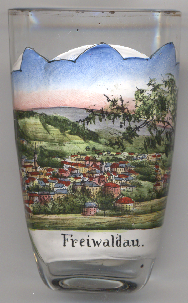
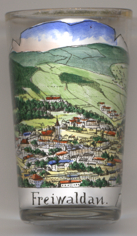 Jeseník, the 'Pearl of the Jeseníky', is situated at an elevation of 432 m on the confluence of
the Bělá (Biele) and Staříč (Staritz) streams on the northeastern slopes of the Hrubý
Jeseník (Altvater, Gesenke) mountain region, about 61 km northwest of Opava and about
80 km north of the regional capital Olomouc. The district town has a population of about
11,200 (2019).
Jeseník, the 'Pearl of the Jeseníky', is situated at an elevation of 432 m on the confluence of
the Bělá (Biele) and Staříč (Staritz) streams on the northeastern slopes of the Hrubý
Jeseník (Altvater, Gesenke) mountain region, about 61 km northwest of Opava and about
80 km north of the regional capital Olomouc. The district town has a population of about
11,200 (2019).
Freiwaldau in the Duchy of Silesia was first mentioned in 1267, when it already held the status of a town belonging to the territory of the Bishops of Wrocław (Breslau). With the surrounding villages it became part of the bishops' ecclesiastical Duchy of Nysa in 1290. In the 14th century Freiwaldau developed as a centre of iron production with several foundries and hammer mills processing the ore from the productive deposits in the surrounding mountains. Later on, the flourishing town was purchased by the Swabian Fugger dynasty from Augsburg. In 1506 it was awarded the status of a mining town. After the iron ore deposits were exhausted, the Fugger sold the town back to the Wrocław bishops in 1547. Silesia with the Lands of the Bohemian Crown had passed to the Austrian Habsburg Monarchy in 1526; after the First Silesian War it became part of Austrian Silesia in 1742. It remained with the Austrian Empire and the Austro-Hungarian Monarchy until World War I and the creation of Czechoslovakia in 1918 (whereupon the name was changed to the Czech Frýwaldov). After World War II, the German population was expelled in 1945 and the municipality in 1948 was renamed Jeseník. The district of Jeseník was joined to that of Šumperk in 1960, but was re-established in 1995.
The composer Carl Ditters von Dittersdorf (1739–1799) resided in Freiwaldau/Frýwaldov as administrator from
1773 until 1794.
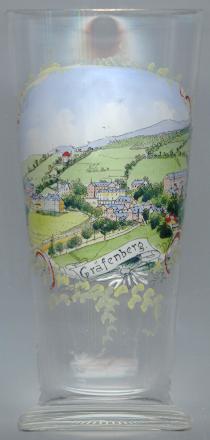
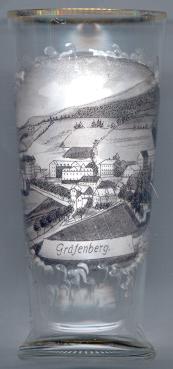
The village of  Lázně Jeseník (until 1947 in Czech: Gräfenberk; in German:
Gräfenberg, elevation 632 m) today is part of the municipality of Jeseník.
The village was founded in 1808 and originally was named Grabenberg or Gräbenberg, like the mountain above the settlement,
mentioned in 1716. The village became a popular spa when the founder of hydropathy, Vinzenz Prießnitz (1799–1851), opened the first
establishment for cold-water cures in 1826. It was renamed to the more luxurious Gräfenberg in 1836. In 1849 the village became
part of the municipality of Jeseník. The Prießnitz spa treatment complex opened in 1910.
Lázně Jeseník (until 1947 in Czech: Gräfenberk; in German:
Gräfenberg, elevation 632 m) today is part of the municipality of Jeseník.
The village was founded in 1808 and originally was named Grabenberg or Gräbenberg, like the mountain above the settlement,
mentioned in 1716. The village became a popular spa when the founder of hydropathy, Vinzenz Prießnitz (1799–1851), opened the first
establishment for cold-water cures in 1826. It was renamed to the more luxurious Gräfenberg in 1836. In 1849 the village became
part of the municipality of Jeseník. The Prießnitz spa treatment complex opened in 1910.
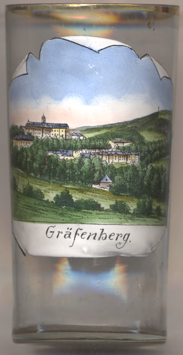
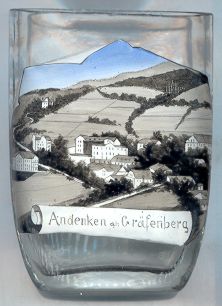
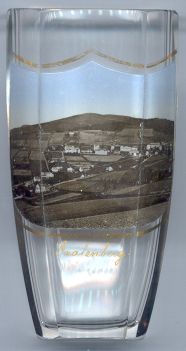
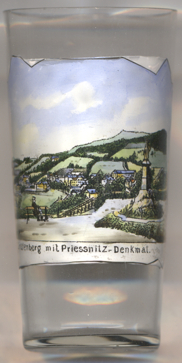
The picture on glass no. 3926 [left] is labeled Gräfenberg mit Priessnitz-Denkmal,
i.e. 'Gräfenberg with Priessnitz monument'. In fact, the monument depicted in the foreground right is known today
as the  Bohemian
Bohemian
[https://de.wikipedia.org/wiki/Jeseník, https://cs.wikipedia.org/wiki/Jeseník;
https://cs.wikipedia.org/wiki/Okres_Jeseník;
https://de.wikipedia.org/wiki/Carl_Ditters_von_Dittersdorf, https://en.wikipedia.org/wiki/Carl_Ditters_von_Dittersdorf;
https://de.wikipedia.org/wiki/Vincenz_Prießnitz;
https://www.google.com/url?sa=t&rct=j&q=&esrc=s&source=web&cd=&ved=2ahUKEwiDwsjhtLztAhWGMBQKHXWWDb8QFjAMegQIExAC&url=https%3A%2F%2Fwww.jesenik.org%2Fsystem%2Fdownload.php%3Fid%3D21281%26mid%3D1761%26lang%3Dcz&usg=AOvVaw2TKt87dfLomedRb5yS_kNO]
![[scale]](lineal.jpg)